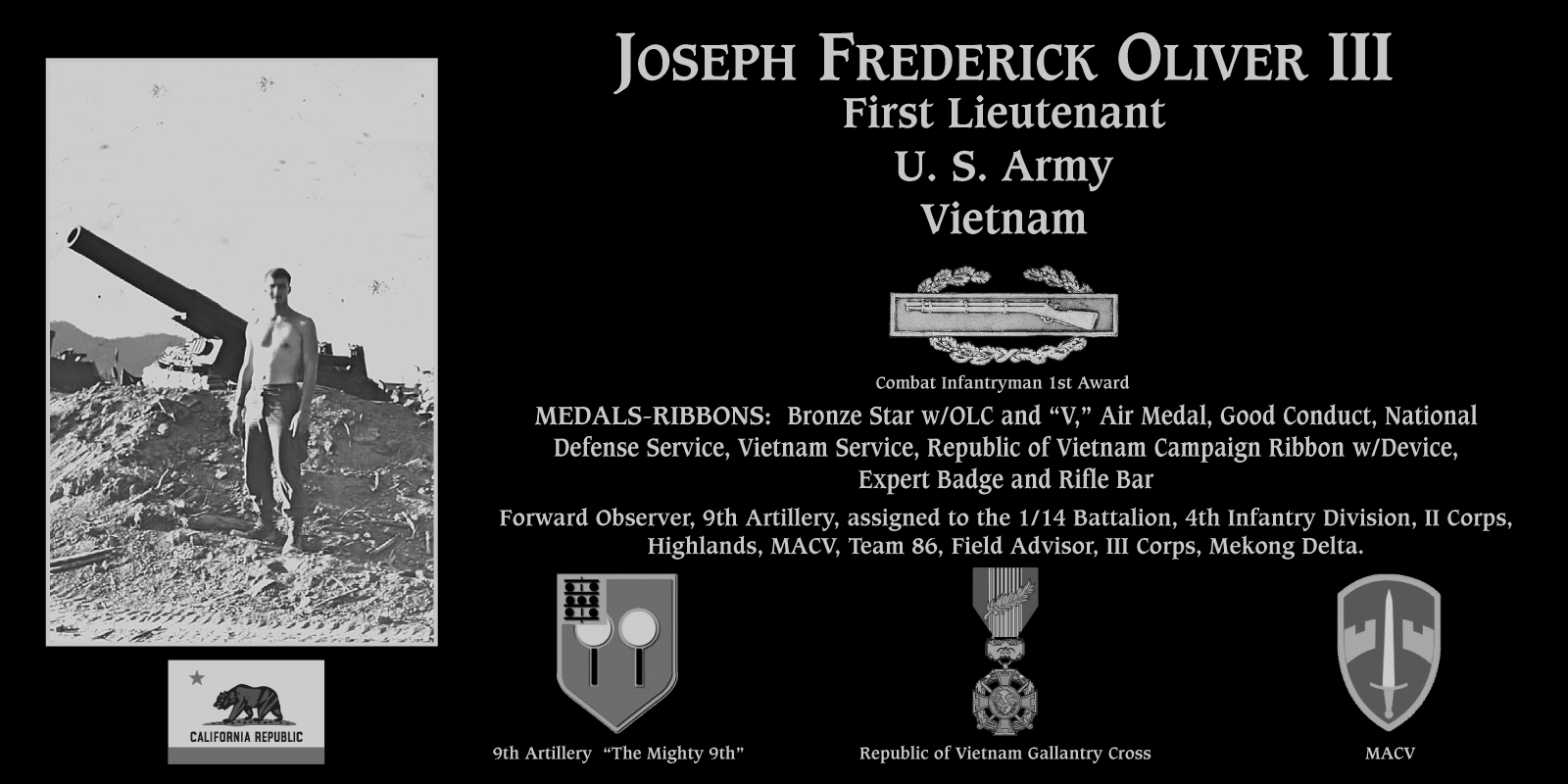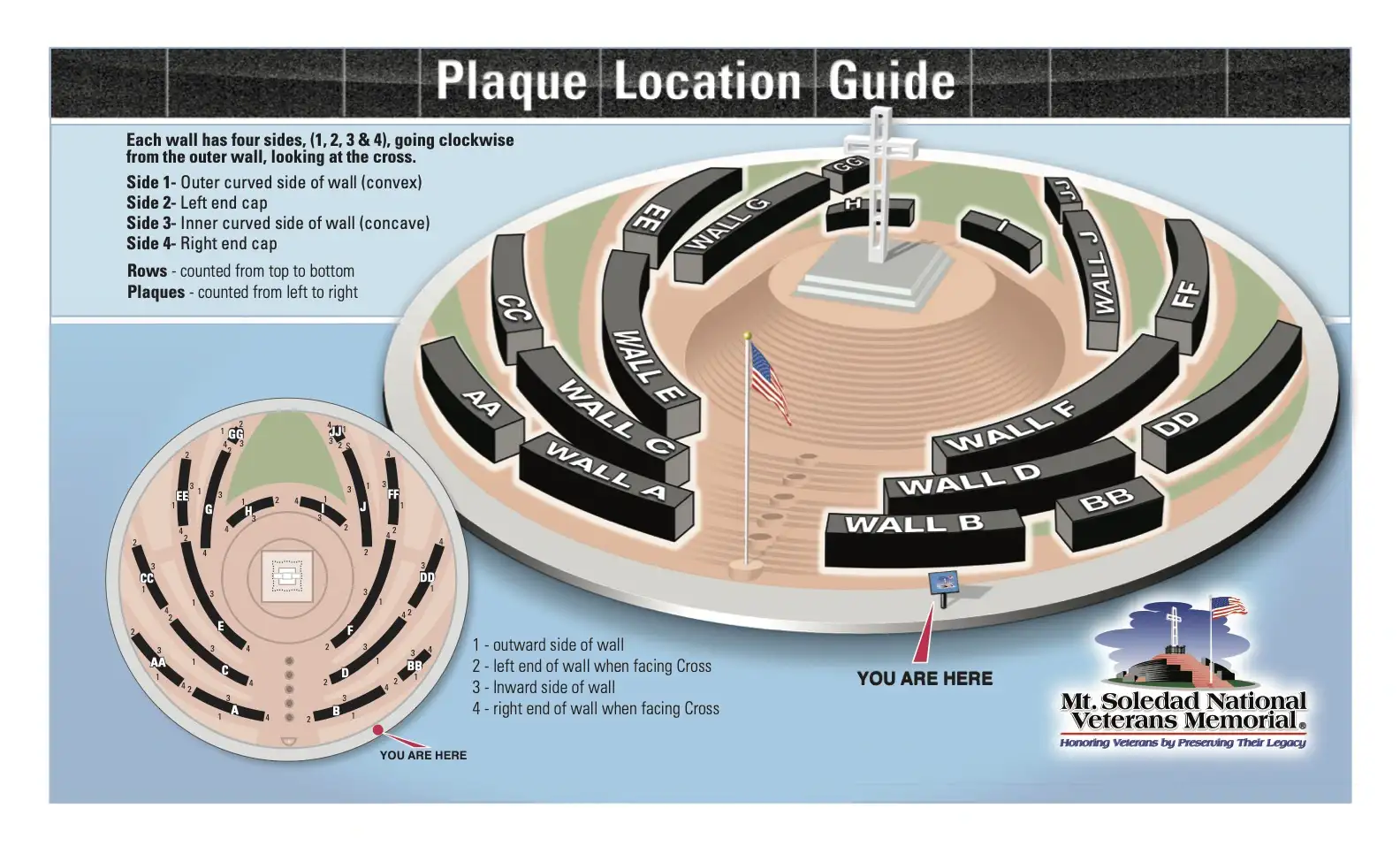Joseph Frederick Oliver III

| Era | Vietnam War |
|---|---|
| Branch | U.S. Army |
| Rank | First Lieutenant |
| Military Decorations | Bronze Star |
| Wall | I |
| Wall Side | 1 |
| Row | 2 |
| Plaque Number | 16 |
Joseph Frederick Oliver's Biography
My memories are a bit faded after 56 years but on or about 4-29-68
while being assigned as a forward observer for Alpha Company 1/14
3rd Brigade of the 4th Infantry Division, which at the time was in the
vicinity of the An Loa Valley in South Viet Nam. We had been
transported there by Hueys to a base camp located near Dak To.
Unfortunately I have no written notes left from any assignment,
however the memory of this nightmare will forever be part of my life.
Battalion headquarters briefed our company commander, Captain
Carter, that there was NVA activity in the Chu Ta mountains and the
company was to conduct a search and destroy mission. Captain
Carter led the light company of 125 men up into the highlands. After
a 9 hour hike with no enemy contact we set up a dry camp with no
tents, only C rations, and canteens filled with spring water laced with
iodine tablets. We set up three two men out posts and I identified four
points of vulnerability to order a fire mission with smoke rounds into
those points in case of an attack.There was no activity that night
which made for an easier trek up the double canopy mountainside
the next morning. Captain Carter sent out a three man point unit and
two three men side flanks. As we proceeded to hump up the
mountain we could see well used trails and both abandoned NVA and
US Army firing positions left from previous years of fire fights. At
about 1100 hours we took a break for a lunch and bit of rest. Captain
Carter radioed a report to the platoon leaders around 1145 hours.
Within 15 minutes the point men and the right flank radioed in that
there was significant movement of troops in the area. Ten minutes
later the enemy opened fire with automatic weapons on the right flank
and the point area where our men returned fire. Shortly after enemy
mortar rounds began to impact the area near the point mens location.
I identified the area the best I could on the map where the men were
being hammered and called for fire with an impact zone 250 meters
farther up the mountain. I called for a round of smoke which landed
significantly farther up the hill from where I had anticipated. It was
difficult to get readings from where I was located in the double
canopy jungle. I asked my RTO Briggs to saddle up the radio and
follow me up the hill to a better viewing area near a craig in the
mountain where I could see through the jungle. Captain Carter was
requesting gunship support but the ships were already committed
and there was no support available. Briggs and I had taken no more
than twenty paces when two 60mm rounds landed in our immediate
area wounding my RTO Briggs , my Recon Sargent, Captain Carter,
the Staff Sargent, and two soldiers. Fortunately I was not injured but
the radio on Brigg’s back was severely damaged by the impact of one
of the rounds. The medic addressed the wounded as best he could
and I grabbed the radio from the second squad leader and I
proceeded up the hill and called for another smoke with a 50 meter
drop in adjustment. The smoke round impact was deflected by the
canopy. The FDC informed me that given the fire base location and
alignment that it would be dangerous to provide the support. In the
meantime the fire fight continued with little maneuvering by our
grunts and an ongoing onslaught of 60mm rounds. The fire direction
center reached out to me with news that there was a 8” gun 12 Ks
away that could make the shot. With new frequencies I contacted the
related 8” gun FDC and called for a single round to make sure the
round would get through the canopy before exploding. Given the
battery location when fired the 8” round sounded a bit like a waffling
freight train as it sailed over our heads impacting 200 meters up the
hillside. I got immediate response from our troops that the round was
still too high above the NVA who had dug in their two 60mm mortar
tubes. Given how dangerous 8” round killing radius could impact our
men, I resolved to move farther up the hill. I was moving awkwardly
given I was carrying my M16, three bandoliers, 7 grenades, two
canteens, and the radio. I heard movement from the area to my lower
right, and given I was making another “danger close” adjustment with
the FDC, I elected to throw a grenade into that area. I pulled the pin
and was about to throw it when the sound became recognizable as
our men. I finally relocated the pulled pin and gingerly reinserted it
into the grenade. Just then semi- automatic fire opened up towards
our men from higher up the hill and it was met with returned fire. I
called for a significant correction of fire from the 8” gun which quickly
silenced the NVA fire for a short while. I then proceeded up the hill
making adjustments and calling for one available round at a time. In
time I noticed that the NVA’s 60mm tubes had been relocated farther
up the mountain. The 8” rounds were certainly beginning to have a
significant impact. I changed frequencies back to the company and
learned that the gun ships that Captain Carter had requested earlier
were still unavailable. I also learned that a mechanized unit in a
nearby valley had requested that I defer from using the 8” gun for fear
that the rounds could possibly soar over the mountain and into their
camp. I “laughed” in profanity which the armored group reluctantly
understood and negated their request. Next I entered an area where a
fire had leveled a bamboo thicket within the past 90 days. Pausing I
looked up the hill and was lucky to spot an NVA spotter’s glasses
reflecting the light for just a moment and could sense a calmness that
quieted my nerves. Refocusing I got a burst of energy and crawled
farther up the hill to an impact crater left by one of the 8” rounds I had
called in earlier. From that position I could hear the report of two
60mmm rounds being fired by the NVA troops. Looking back from my
position in the crater sadly I saw that two of our men who had been
moving up behind me and into the vicinity I had just vacated had
been severely wounded by the impact of the two rounds. I moved on
up to the next crater and adjusted fire to where I had seen the
reflection off the glass earlier and figured it was approximately 100
meters from where I laid. I requested three rounds in rapid fire. The
impacts were significant and silenced the mortars. Proceeding up the
hill I encountered single fire rounds and jumped into the last of the
three round craters and was calling for another adjustment when a
Chicon grenade was tossed into my location. From out of no where
the Second Platoon leader jumped into the crater with me and picked
up the grenade and threw it out where it immediately exploded. He
had saved us both from severe injury or death. While I made fire
adjustments my hero looked over the brim of the crater and opened
fire with his M16. Fire was returned and he lobbed a frag grenade
which silenced the NVA fire. Thereafter the balance of the second
platoon moved up the hill and secured the area. I continued calling in
single 8” rounds up to a plateau and eventually all NVA fire stopped.
During the next three hours the men from the company searched the
area. They found a significant number of tunnels. As night
approached a perimeter defense position was established. Medivac
choppers came in and took out 8 severely wounded soldiers to
include my RTO Briggs and Recon Sargent and three KIA. Another 8
wounded men including Captain Carter were tended to by our
medics.
The next day upon further inspection we discovered a tunnel system
that had been vacated by the NVA and had been used as a temporary
field hospital. Surely that is the reason the NVA had maintained
contact for such an extended time.
We held our position for another 48 hours. During the course of this
time we resupplied, shipped more injured men out, received a few
replacement men, and a Catholic priest came out and held a service
in memory of the dead and prayers for the wounded. Eventually
Hueys came in one at a time and moved us back to the fire base
camp where the 8”gun that had given us so much support was
located. After a shower, I ate some hots, and then I thanked the FDC
and crew of the 8”gun who had managed to save so many of our men
with their skills. This is just my story reflecting from that experience
and I am sure all the men whom survived would relive it from their
own perspective but we all would say “Thank God I survived”!
J Fred Oliver III, Husband of Susan Oliver. OCS Fort Sill OK, combat duty in Vietnam 2-68 to 2-69. Artillery 2nd Lt Forward observer with the 4th infantry division in the highlands II Corp for six months. 1st Lt MACV 5-man MAT strike team leader in III Corps. Earned two Bronze stars for valor, Air metal (result of 21 combat assaults) and other awards. Sharing life with Susan Oliver for 50 years. Father of three sons and blessed with five grandchildren.
Plaque Wall Map

